Organizational Behavior: Case Study on Stress, Leadership Styles
VerifiedAdded on 2023/04/08
|5
|934
|317
Case Study
AI Summary
This case study examines Jim Black's stress as a sales representative due to sales decline, job insecurity, and personal pressures, identifying physical stress symptoms and stressors. It also analyzes leadership styles, contrasting Martin's participatory approach with Tom Saunders' reactive style, and proposes solutions for conflict resolution. The study further discusses the traits of an effective leader and suggests communication-based strategies for Martin to address his challenges. Desklib provides access to this and other solved assignments for students.
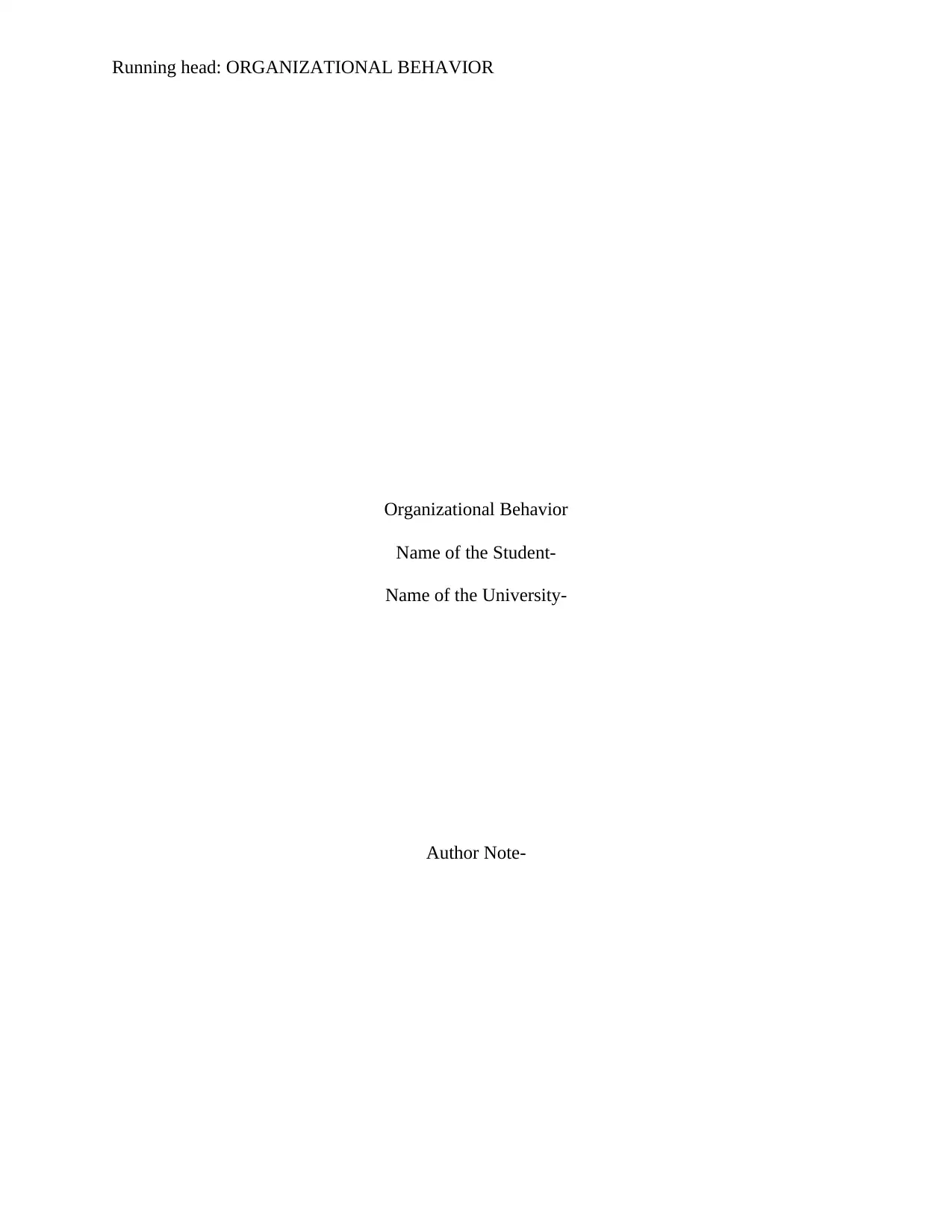
Running head: ORGANIZATIONAL BEHAVIOR
Organizational Behavior
Name of the Student-
Name of the University-
Author Note-
Organizational Behavior
Name of the Student-
Name of the University-
Author Note-
Paraphrase This Document
Need a fresh take? Get an instant paraphrase of this document with our AI Paraphraser
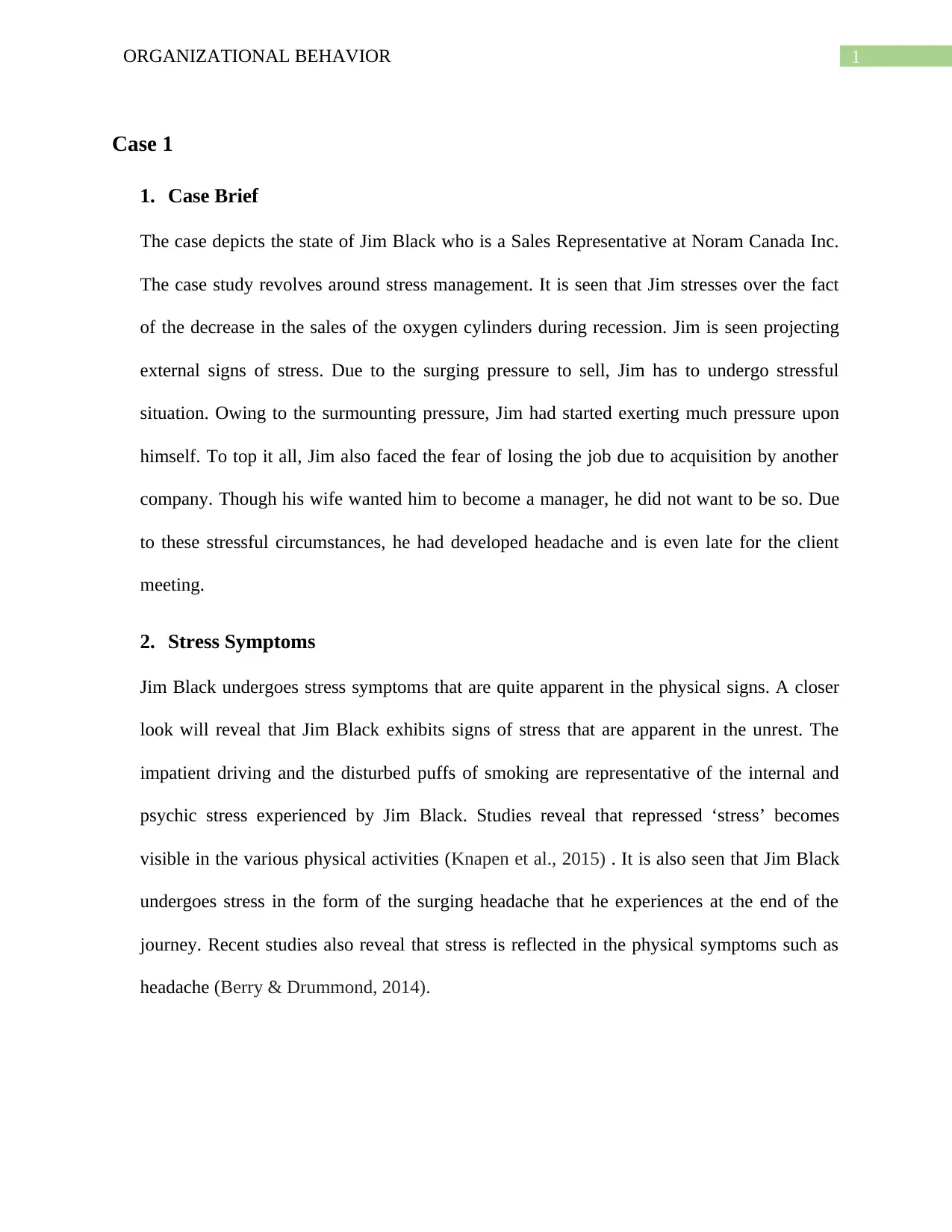
1ORGANIZATIONAL BEHAVIOR
Case 1
1. Case Brief
The case depicts the state of Jim Black who is a Sales Representative at Noram Canada Inc.
The case study revolves around stress management. It is seen that Jim stresses over the fact
of the decrease in the sales of the oxygen cylinders during recession. Jim is seen projecting
external signs of stress. Due to the surging pressure to sell, Jim has to undergo stressful
situation. Owing to the surmounting pressure, Jim had started exerting much pressure upon
himself. To top it all, Jim also faced the fear of losing the job due to acquisition by another
company. Though his wife wanted him to become a manager, he did not want to be so. Due
to these stressful circumstances, he had developed headache and is even late for the client
meeting.
2. Stress Symptoms
Jim Black undergoes stress symptoms that are quite apparent in the physical signs. A closer
look will reveal that Jim Black exhibits signs of stress that are apparent in the unrest. The
impatient driving and the disturbed puffs of smoking are representative of the internal and
psychic stress experienced by Jim Black. Studies reveal that repressed ‘stress’ becomes
visible in the various physical activities (Knapen et al., 2015) . It is also seen that Jim Black
undergoes stress in the form of the surging headache that he experiences at the end of the
journey. Recent studies also reveal that stress is reflected in the physical symptoms such as
headache (Berry & Drummond, 2014).
Case 1
1. Case Brief
The case depicts the state of Jim Black who is a Sales Representative at Noram Canada Inc.
The case study revolves around stress management. It is seen that Jim stresses over the fact
of the decrease in the sales of the oxygen cylinders during recession. Jim is seen projecting
external signs of stress. Due to the surging pressure to sell, Jim has to undergo stressful
situation. Owing to the surmounting pressure, Jim had started exerting much pressure upon
himself. To top it all, Jim also faced the fear of losing the job due to acquisition by another
company. Though his wife wanted him to become a manager, he did not want to be so. Due
to these stressful circumstances, he had developed headache and is even late for the client
meeting.
2. Stress Symptoms
Jim Black undergoes stress symptoms that are quite apparent in the physical signs. A closer
look will reveal that Jim Black exhibits signs of stress that are apparent in the unrest. The
impatient driving and the disturbed puffs of smoking are representative of the internal and
psychic stress experienced by Jim Black. Studies reveal that repressed ‘stress’ becomes
visible in the various physical activities (Knapen et al., 2015) . It is also seen that Jim Black
undergoes stress in the form of the surging headache that he experiences at the end of the
journey. Recent studies also reveal that stress is reflected in the physical symptoms such as
headache (Berry & Drummond, 2014).
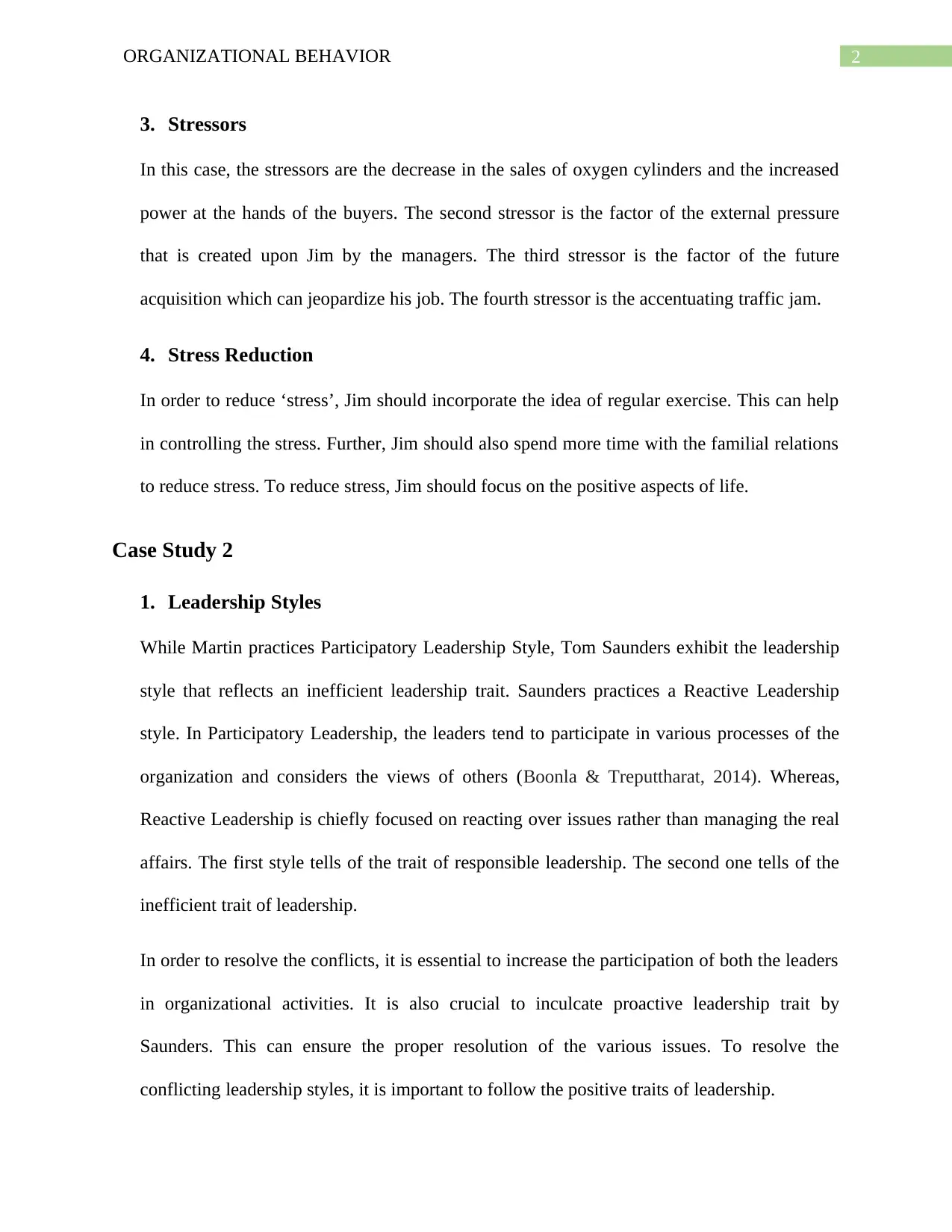
2ORGANIZATIONAL BEHAVIOR
3. Stressors
In this case, the stressors are the decrease in the sales of oxygen cylinders and the increased
power at the hands of the buyers. The second stressor is the factor of the external pressure
that is created upon Jim by the managers. The third stressor is the factor of the future
acquisition which can jeopardize his job. The fourth stressor is the accentuating traffic jam.
4. Stress Reduction
In order to reduce ‘stress’, Jim should incorporate the idea of regular exercise. This can help
in controlling the stress. Further, Jim should also spend more time with the familial relations
to reduce stress. To reduce stress, Jim should focus on the positive aspects of life.
Case Study 2
1. Leadership Styles
While Martin practices Participatory Leadership Style, Tom Saunders exhibit the leadership
style that reflects an inefficient leadership trait. Saunders practices a Reactive Leadership
style. In Participatory Leadership, the leaders tend to participate in various processes of the
organization and considers the views of others (Boonla & Treputtharat, 2014). Whereas,
Reactive Leadership is chiefly focused on reacting over issues rather than managing the real
affairs. The first style tells of the trait of responsible leadership. The second one tells of the
inefficient trait of leadership.
In order to resolve the conflicts, it is essential to increase the participation of both the leaders
in organizational activities. It is also crucial to inculcate proactive leadership trait by
Saunders. This can ensure the proper resolution of the various issues. To resolve the
conflicting leadership styles, it is important to follow the positive traits of leadership.
3. Stressors
In this case, the stressors are the decrease in the sales of oxygen cylinders and the increased
power at the hands of the buyers. The second stressor is the factor of the external pressure
that is created upon Jim by the managers. The third stressor is the factor of the future
acquisition which can jeopardize his job. The fourth stressor is the accentuating traffic jam.
4. Stress Reduction
In order to reduce ‘stress’, Jim should incorporate the idea of regular exercise. This can help
in controlling the stress. Further, Jim should also spend more time with the familial relations
to reduce stress. To reduce stress, Jim should focus on the positive aspects of life.
Case Study 2
1. Leadership Styles
While Martin practices Participatory Leadership Style, Tom Saunders exhibit the leadership
style that reflects an inefficient leadership trait. Saunders practices a Reactive Leadership
style. In Participatory Leadership, the leaders tend to participate in various processes of the
organization and considers the views of others (Boonla & Treputtharat, 2014). Whereas,
Reactive Leadership is chiefly focused on reacting over issues rather than managing the real
affairs. The first style tells of the trait of responsible leadership. The second one tells of the
inefficient trait of leadership.
In order to resolve the conflicts, it is essential to increase the participation of both the leaders
in organizational activities. It is also crucial to inculcate proactive leadership trait by
Saunders. This can ensure the proper resolution of the various issues. To resolve the
conflicting leadership styles, it is important to follow the positive traits of leadership.
⊘ This is a preview!⊘
Do you want full access?
Subscribe today to unlock all pages.

Trusted by 1+ million students worldwide
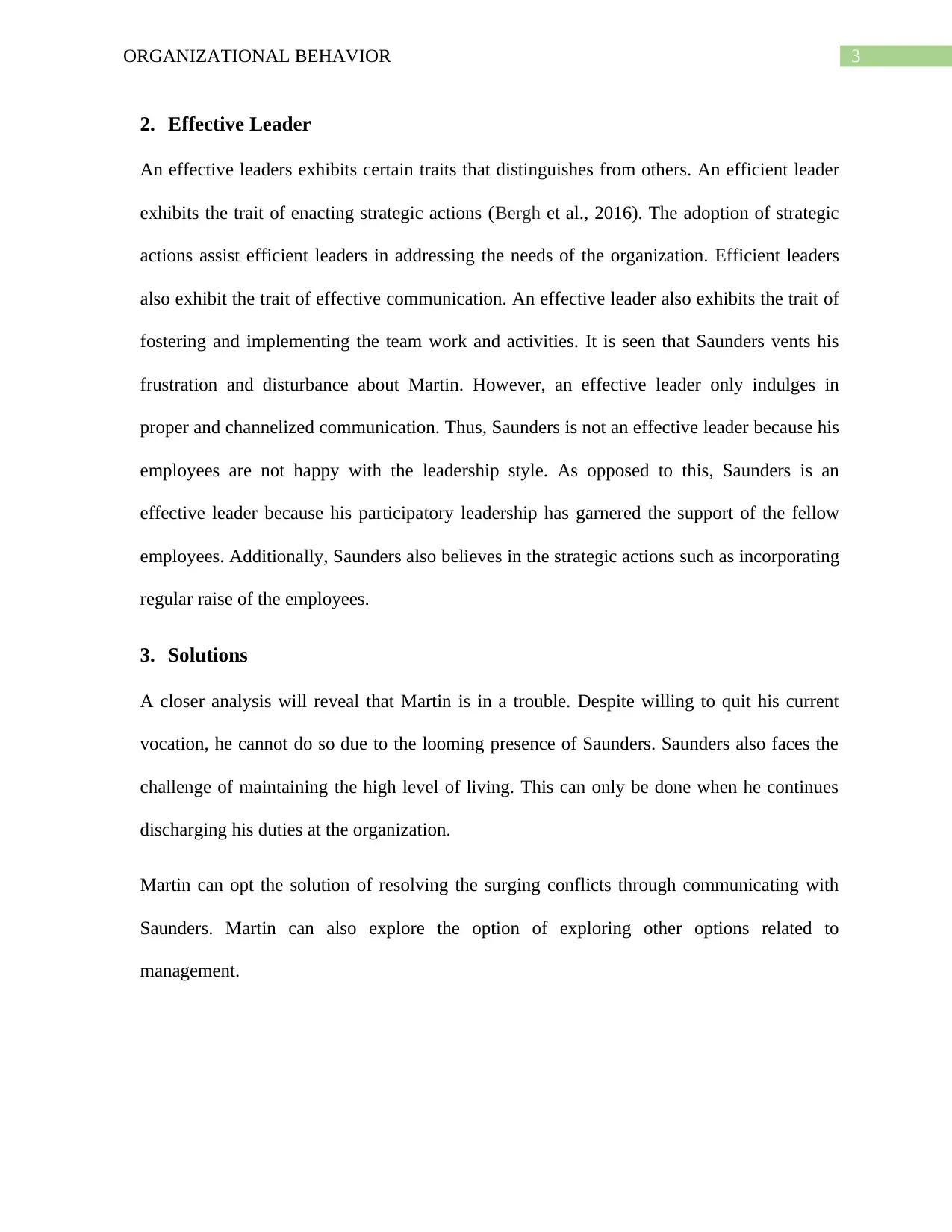
3ORGANIZATIONAL BEHAVIOR
2. Effective Leader
An effective leaders exhibits certain traits that distinguishes from others. An efficient leader
exhibits the trait of enacting strategic actions (Bergh et al., 2016). The adoption of strategic
actions assist efficient leaders in addressing the needs of the organization. Efficient leaders
also exhibit the trait of effective communication. An effective leader also exhibits the trait of
fostering and implementing the team work and activities. It is seen that Saunders vents his
frustration and disturbance about Martin. However, an effective leader only indulges in
proper and channelized communication. Thus, Saunders is not an effective leader because his
employees are not happy with the leadership style. As opposed to this, Saunders is an
effective leader because his participatory leadership has garnered the support of the fellow
employees. Additionally, Saunders also believes in the strategic actions such as incorporating
regular raise of the employees.
3. Solutions
A closer analysis will reveal that Martin is in a trouble. Despite willing to quit his current
vocation, he cannot do so due to the looming presence of Saunders. Saunders also faces the
challenge of maintaining the high level of living. This can only be done when he continues
discharging his duties at the organization.
Martin can opt the solution of resolving the surging conflicts through communicating with
Saunders. Martin can also explore the option of exploring other options related to
management.
2. Effective Leader
An effective leaders exhibits certain traits that distinguishes from others. An efficient leader
exhibits the trait of enacting strategic actions (Bergh et al., 2016). The adoption of strategic
actions assist efficient leaders in addressing the needs of the organization. Efficient leaders
also exhibit the trait of effective communication. An effective leader also exhibits the trait of
fostering and implementing the team work and activities. It is seen that Saunders vents his
frustration and disturbance about Martin. However, an effective leader only indulges in
proper and channelized communication. Thus, Saunders is not an effective leader because his
employees are not happy with the leadership style. As opposed to this, Saunders is an
effective leader because his participatory leadership has garnered the support of the fellow
employees. Additionally, Saunders also believes in the strategic actions such as incorporating
regular raise of the employees.
3. Solutions
A closer analysis will reveal that Martin is in a trouble. Despite willing to quit his current
vocation, he cannot do so due to the looming presence of Saunders. Saunders also faces the
challenge of maintaining the high level of living. This can only be done when he continues
discharging his duties at the organization.
Martin can opt the solution of resolving the surging conflicts through communicating with
Saunders. Martin can also explore the option of exploring other options related to
management.
Paraphrase This Document
Need a fresh take? Get an instant paraphrase of this document with our AI Paraphraser
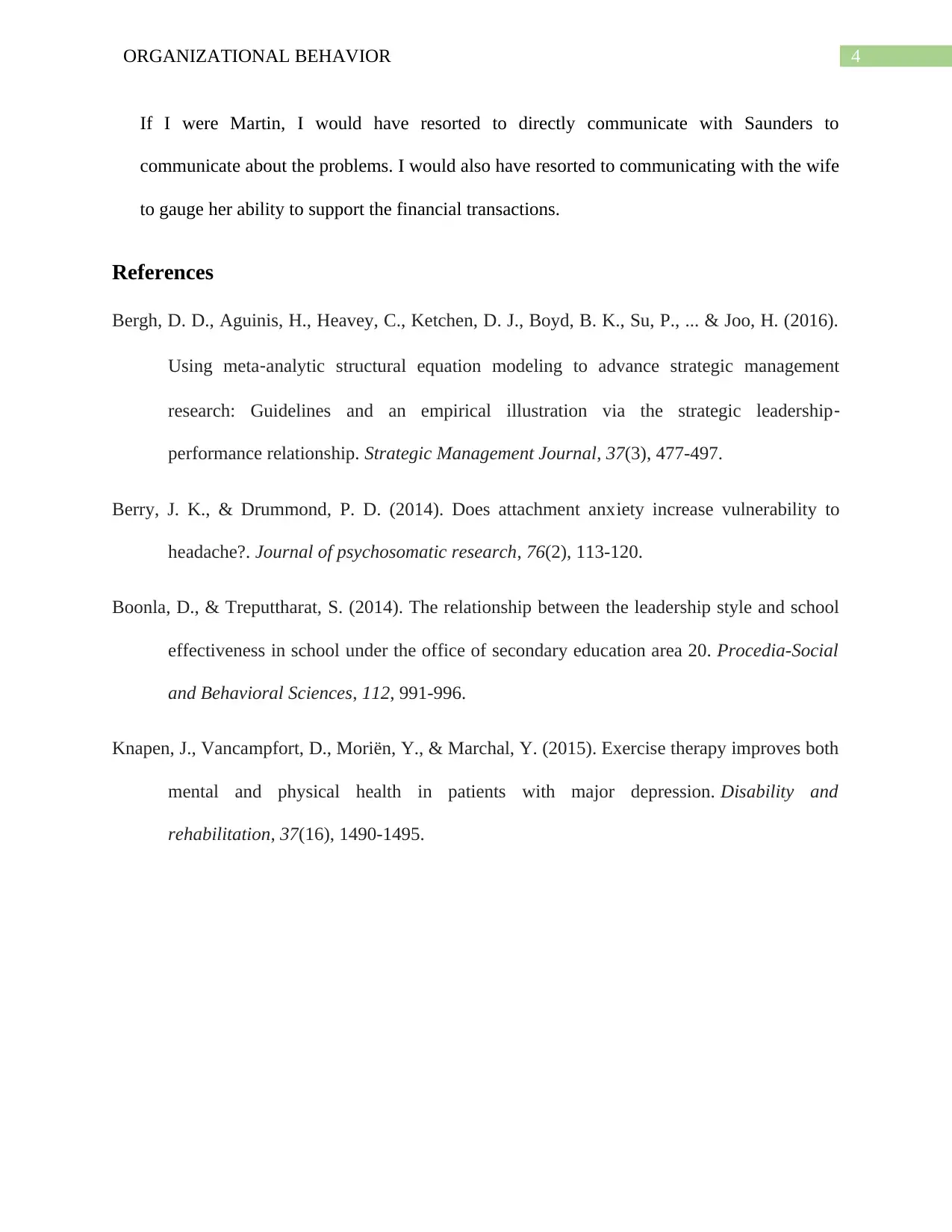
4ORGANIZATIONAL BEHAVIOR
If I were Martin, I would have resorted to directly communicate with Saunders to
communicate about the problems. I would also have resorted to communicating with the wife
to gauge her ability to support the financial transactions.
References
Bergh, D. D., Aguinis, H., Heavey, C., Ketchen, D. J., Boyd, B. K., Su, P., ... & Joo, H. (2016).
Using meta‐analytic structural equation modeling to advance strategic management
research: Guidelines and an empirical illustration via the strategic leadership‐
performance relationship. Strategic Management Journal, 37(3), 477-497.
Berry, J. K., & Drummond, P. D. (2014). Does attachment anxiety increase vulnerability to
headache?. Journal of psychosomatic research, 76(2), 113-120.
Boonla, D., & Treputtharat, S. (2014). The relationship between the leadership style and school
effectiveness in school under the office of secondary education area 20. Procedia-Social
and Behavioral Sciences, 112, 991-996.
Knapen, J., Vancampfort, D., Moriën, Y., & Marchal, Y. (2015). Exercise therapy improves both
mental and physical health in patients with major depression. Disability and
rehabilitation, 37(16), 1490-1495.
If I were Martin, I would have resorted to directly communicate with Saunders to
communicate about the problems. I would also have resorted to communicating with the wife
to gauge her ability to support the financial transactions.
References
Bergh, D. D., Aguinis, H., Heavey, C., Ketchen, D. J., Boyd, B. K., Su, P., ... & Joo, H. (2016).
Using meta‐analytic structural equation modeling to advance strategic management
research: Guidelines and an empirical illustration via the strategic leadership‐
performance relationship. Strategic Management Journal, 37(3), 477-497.
Berry, J. K., & Drummond, P. D. (2014). Does attachment anxiety increase vulnerability to
headache?. Journal of psychosomatic research, 76(2), 113-120.
Boonla, D., & Treputtharat, S. (2014). The relationship between the leadership style and school
effectiveness in school under the office of secondary education area 20. Procedia-Social
and Behavioral Sciences, 112, 991-996.
Knapen, J., Vancampfort, D., Moriën, Y., & Marchal, Y. (2015). Exercise therapy improves both
mental and physical health in patients with major depression. Disability and
rehabilitation, 37(16), 1490-1495.
1 out of 5
Your All-in-One AI-Powered Toolkit for Academic Success.
+13062052269
info@desklib.com
Available 24*7 on WhatsApp / Email
![[object Object]](/_next/static/media/star-bottom.7253800d.svg)
Unlock your academic potential
Copyright © 2020–2025 A2Z Services. All Rights Reserved. Developed and managed by ZUCOL.